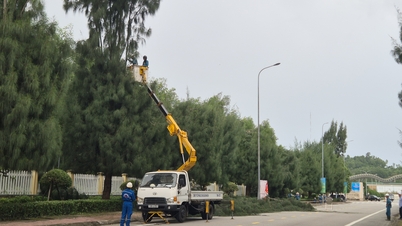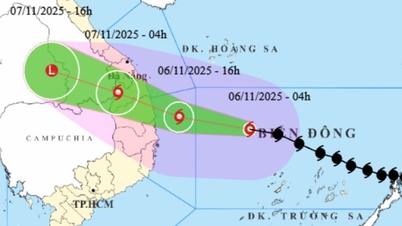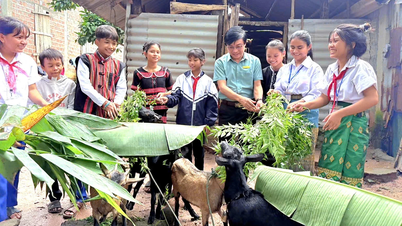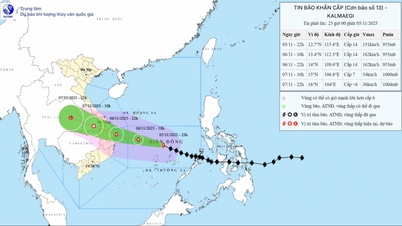In January 2024 alone, Vietnam's total agricultural export turnover reached 5.14 billion USD, up 79.2% over the same period last year. Most groups and industries grew, expecting a breakthrough this year.

Ceremony to announce the export of green-skinned elephant mangoes from Cho Moi district ( An Giang province) to the US and Australian markets, January 2024. Photo: Thanh Sang
Growth in most markets
In January 2024, Vietnam had a series of agricultural export orders to major markets. For example, a batch of green-skinned elephant mangoes from Cho Moi district, An Giang province was exported to the US and Australian markets.
According to Deputy General Director of Vina T&T Import Export Company Limited Nguyen Dinh Muoi, this year could be a breakthrough year for the fruit industry, as a series of products have received good signals from major markets such as Japan, the United States, Australia, China, the EU... It is worth mentioning that the potential of most of these markets is very large, the door is wide open for Vietnamese fruits.
Similarly, rice is also looking forward to a successful year, as signals from the markets are quite positive. From the beginning of 2024, many rice exporting enterprises have received orders.
Chairman of the Board of Directors of Trung An High-Tech Agriculture Joint Stock Company Pham Thai Binh said that the price of 5% broken rice in Vietnam is currently not less than 700 USD/ton. In 2024, the minimum amount of rice exported by Vietnam may be the same as in 2023, but the value will certainly be 15 to 20% higher. Therefore, in 2023, the revenue was 4.8 billion USD, then in 2024, the expected rice turnover must be more than 5 billion USD.
Thus, Vietnam's rice export door is quite bright this year. Although the price of paddy and rice still depends largely on whether India considers lifting the ban on rice exports or not, the price of this commodity in 2024 may still be high.
According to the World Food Organization (FAO), the world is short of about 5 million tons of rice. Deputy Director of the Department of Quality, Processing and Market Development ( Ministry of Agriculture and Rural Development ) Le Thanh Hoa informed that the current global rice inventory has decreased to just over 160 million tons. This is a great opportunity for Vietnamese rice products that businesses need to take advantage of to break through.
The export recovery in the first month of 2024 also includes the seafood industry. 2023 was a difficult year for this industry, but from January to 2024, seafood exports increased in many markets, signaling a recovery.
Assessing agricultural exports in the first month of the year, Deputy Minister of Agriculture and Rural Development Phung Duc Tien said that in January 2024, Vietnam's total agricultural, forestry and fishery export turnover reached 5.14 billion USD, up 79.2% over the same period last year and the export value of agricultural products also increased. Of which, agricultural products reached 2.71 billion USD, up 93.8%; forestry products 1.49 billion USD, up 72.5%; aquatic products 730 million USD, up 60.8%; livestock 36 million USD, up 3.5%... China continues to be the largest agricultural import market of Vietnam, accounting for 23% (up 106.9%). Next is the US market accounting for 20.8% (up 95.9%) and Japan accounting for 7.4% (up 47.5%).
Have specific strategies for each industry
According to Deputy Minister of Agriculture and Rural Development Phung Duc Tien, the agricultural sector has set a target of exporting about 54-55 billion USD worth of agricultural products by 2024. Of which, vegetables, fruits, rice, seafood, and forestry products are the key products, expected to contribute greatly to the growth of the entire sector.
Experts believe that the agricultural sector will successfully reach the finish line, even surpassing the set target, because many industries promise to have major breakthroughs. General Secretary of the Vietnam Fruit and Vegetable Association Dang Phuc Nguyen said that in 2024, Vietnam's fruit and vegetable industry is forecast to grow by about 15-20%, continue to set new peaks, possibly surpassing 6 billion USD, even reaching 7 billion USD. Currently, the Vietnam Fruit and Vegetable Association is coordinating with the Ministry of Agriculture and Rural Development and businesses to implement many activities to promote the development of the fruit and vegetable industry.
“Vietnam’s vegetable and fruit resources are huge; meanwhile, Vietnam’s vegetable and fruit export turnover only accounts for about 2-3% of the world’s total vegetable and fruit export turnover. There is still a lot of room for growth in this industry. The important thing is how to exploit that potential well,” said Mr. Dang Phuc Nguyen.
Similarly, the seafood industry is expected to reach 10 billion USD in export turnover this year, as many markets are showing signs of growth again. In addition, the agricultural sector also expects rice, forestry products, and wooden products to have a year of recovery and prosperity to increase the export value of the entire industry.
The advantages are quite large, but there are also difficulties and challenges. Deputy Minister of Agriculture and Rural Development Phung Duc Tien said that the failure to fully exploit the strengths of deep processing, brand building, as well as quality requirements are still barriers for Vietnamese agricultural products. Although in recent times, Vietnamese agricultural products have changed in quality, and many businesses have complied with the regulations of the importing side, this is still a big challenge to firmly and sustainably maintain a foothold in import markets.
“To boost agricultural exports and firmly and sustainably maintain a foothold in import markets, the Ministry of Agriculture and Rural Development will work with businesses to monitor and manage the production process well, issue area codes, review criteria, and meet standards from many major markets. The Ministry also analyzes the market to have specific strategies for each period and each industry, creating breakthroughs in agricultural exports. At the same time, the agricultural sector will closely follow major import markets, such as China, the United States, Japan, the EU, etc., to boost exports and exploit new, potential markets, such as Islamic countries, the Middle East, Africa, etc.,” Deputy Minister Phung Duc Tien emphasized.
Source



![[Photo] Opening of the 14th Conference of the 13th Party Central Committee](https://vphoto.vietnam.vn/thumb/1200x675/vietnam/resource/IMAGE/2025/11/05/1762310995216_a5-bnd-5742-5255-jpg.webp)





















![[Photo] Panorama of the Patriotic Emulation Congress of Nhan Dan Newspaper for the period 2025-2030](https://vphoto.vietnam.vn/thumb/1200x675/vietnam/resource/IMAGE/2025/11/04/1762252775462_ndo_br_dhthiduayeuncbaond-6125-jpg.webp)












































































Comment (0)